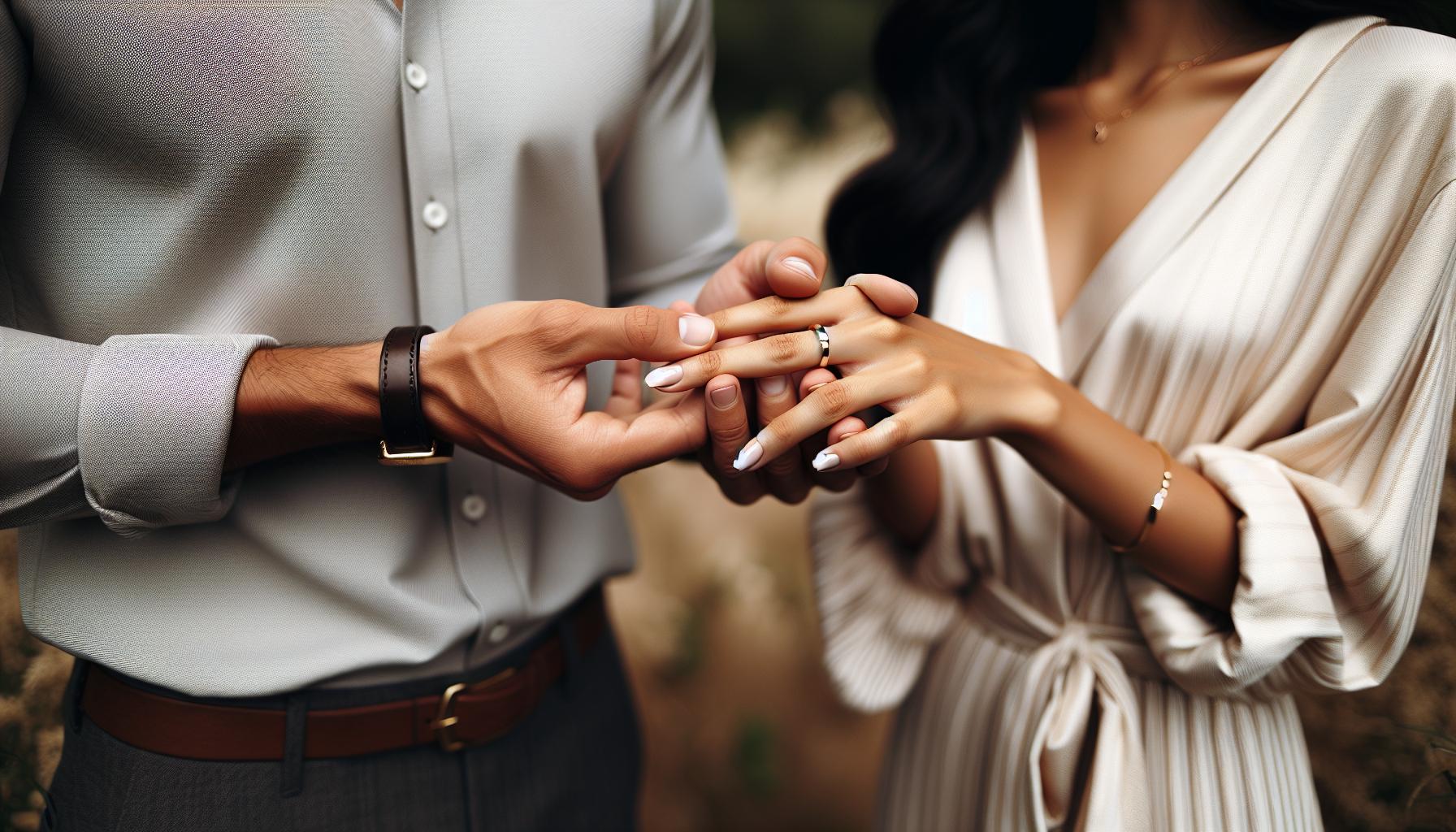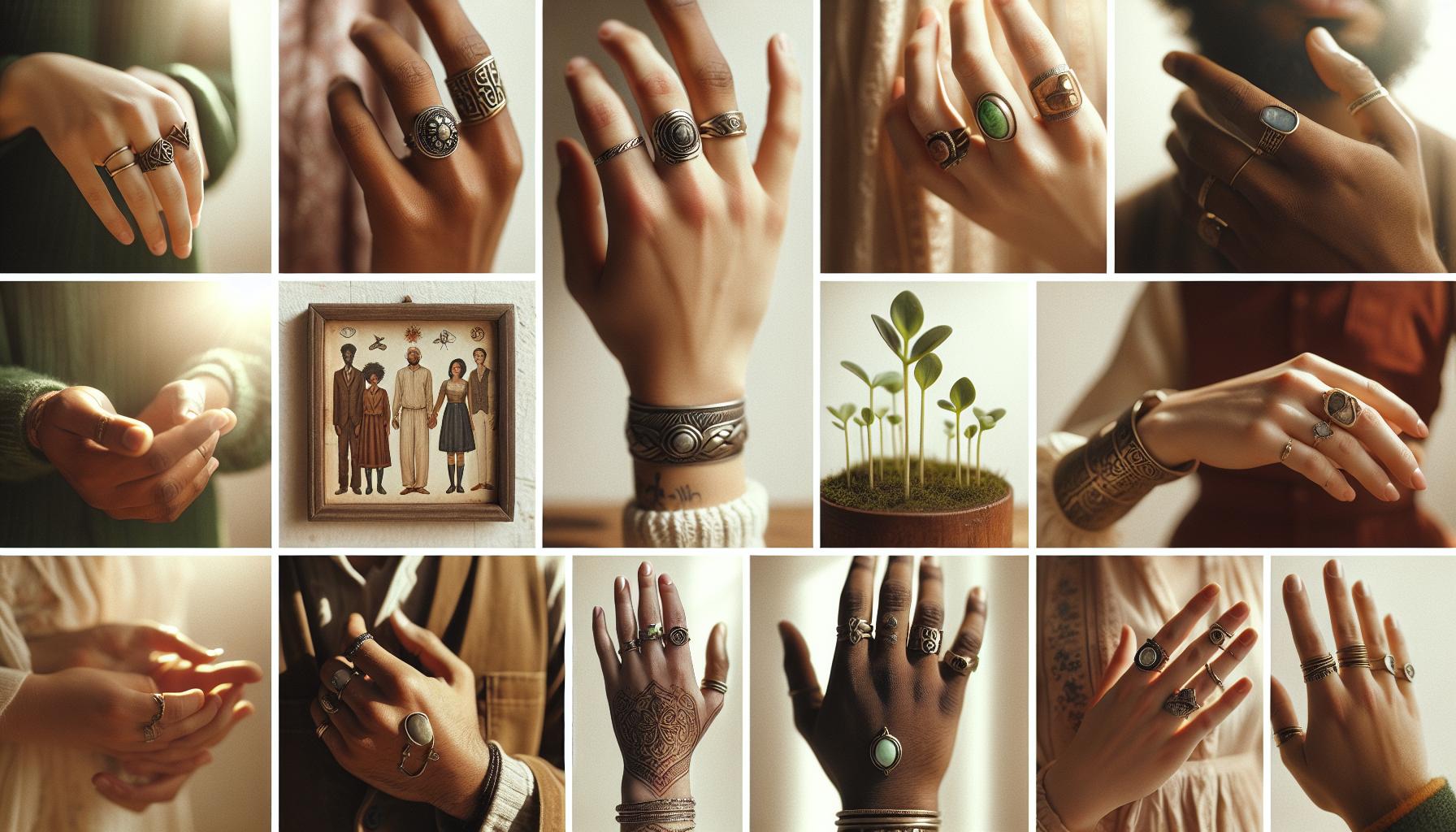Choosing which hand to wear your wedding ring on is more than just a personal decision; it reflects deep-rooted traditions that vary across cultures. Did you know that in some countries, the ring is worn on the right hand, while in others, it rests on the left? Understanding the significance behind these customs can help you honor your heritage or add a unique touch to your celebration. As you embark on your wedding planning journey, knowing the implications of ring placement not only enhances your ceremony’s meaning but also allows you to connect with your loved ones on a deeper level. Join us as we explore this fascinating topic, unraveling the global traditions surrounding the wedding ring hand to help you create memorable moments on your special day.
Choosing the Right Hand for Your Wedding Ring
can be a deeply personal decision, influenced by various factors that reflect your cultural background, personal significance, and even practical considerations. While some cultures hold steadfast traditions regarding which hand to wear the wedding ring-typically the left hand for many Western countries-others may favor the right hand for its symbolism or because it aligns better with local customs. This choice can create a beautiful narrative for your wedding journey, one that resonates with your individual values and beliefs.
Considering your lifestyle and practical needs is essential when deciding on which hand to wear your ring. For example, if you are part of a profession that requires frequent use of your hands, wearing your ring on your less dominant hand might be beneficial to avoid damage or discomfort. Additionally, think about the type of ring you choose; certain styles might be more visually appealing or comfortable on one hand versus the other. Exploring all these angles allows you to find a fitting solution that suits your personality and day-to-day life.
Then there’s the symbolic aspect. Many believe that the left hand is closer to the heart, traditionally making it the favored choice for engagement and wedding rings in many cultures. However, the right hand signifies strength and honor in others, demonstrating that the decision may reflect a deeper meaning. Engage in discussions with your partner about these traditions and their significance. This process can turn into a meaningful moment that strengthens your bond while leading to a decision that feels right for both of you.
Ultimately, selecting the proper hand for your wedding ring is more than a mere choice; it’s about expressing love and commitment in a manner that resonates with who you are as a couple. Embrace this moment in your wedding planning as an opportunity to infuse personal significance into your celebration of love.
Cultural Variations: Wedding Ring Traditions Worldwide
Across the globe, wedding ring traditions vary significantly, reflecting the rich tapestry of cultures and beliefs that shape our understanding of love and commitment. In many Western cultures, it is customary for the wedding ring to be worn on the left hand, often believed to symbolize the connection to the heart-a romantic notion that dates back centuries. However, this practice is not universal; in countries such as Germany, the engagement ring is typically worn on the right hand, only to be moved to the left after the wedding ceremony. This shift not only signifies a transition in status but also represents a bonding of two lives together.
Cultural significance also plays a crucial role in where rings are placed. In several Eastern European countries, such as Russia and Poland, the choice of hand often relates to Slavic tradition, where the wedding band is worn on the right hand. This positioning is said to symbolize strength and honor, with the right hand often seen as the active hand for pledging vows and making promises. On the contrary, in India, some communities may choose to wear rings on other fingers or opt for different adornments altogether, such as toe rings, which hold equal sentiment in expressing marital status.
Another fascinating cultural perspective can be found in some Middle Eastern societies, where elaborate gold wedding bands signify wealth and status. In these cultures, the bride may wear her wedding ring on the right hand initially, but there are no hard rules governing this choice, allowing personal preference to guide the decision. Ultimately, the essence of these customs is rooted in love, reflecting the couple’s unique bond while integrating familial and cultural values.
Understanding these diverse traditions invites couples to personalize their own wedding ring choices, ensuring their decision resonates with their identities. Whether you choose to follow a particular custom or forge your own path, embracing your story’s rich cultural elements can enhance your shared journey into marriage. This beautiful convergence of heritage and personal significance makes the act of wearing a wedding ring not just a tradition but a profound expression of commitment that transcends borders and backgrounds.
The Symbolism Behind Wearing Your Ring on a Specific Hand
The choice of which hand to wear your wedding ring on carries a depth of meaning steeped in tradition and cultural significance. In many Western societies, the left hand is typically favored due to the long-held belief that it contains the “vena amoris” or the vein of love, which connects directly to the heart. This romantic notion imbues the left hand with a symbolic weight, signifying love, commitment, and the heart’s connection to partnership. It’s a powerful expression of the vow taken on your wedding day, encapsulating not just the promise of fidelity, but the bond that two people create in their shared journey.
However, this symbol of unity is not static; it evolves across cultures and customs. In countries like Germany and Russia, the right hand takes precedence, symbolizing strength and honor. Here, the act of wearing the wedding ring on the right hand often marks active participation in the promise made between partners. For many, this shift reinforces the idea that the hand one chooses for their ring reflects personal beliefs and values about marriage and commitment. This choice serves as an outward display of the profound link between partners, transcending personal preference and echoing deep-rooted traditions.
Ultimately, the symbolism behind the hand on which you wear your wedding ring encapsulates the unique narrative of your relationship. Whether you align with traditional practices or choose a path defined by personal significance, wearing your ring on a specific hand can be a celebration of your story. Couples are encouraged to reflect on their identities, values, and cultural backgrounds, making a choice that resonates not just visually, but also emotionally, ensuring that your wedding ring is not just an accessory, but a cherished emblem of love and partnership that carries heartfelt meaning every day.
When Did the Tradition of the Wedding Ring Begin?
The tradition of wearing wedding rings dates back thousands of years, making it one of the oldest rituals associated with marriage. The earliest known usage of wedding rings can be traced back to Ancient Egypt, around 3000 BCE. The Egyptians believed that the circular shape of a ring symbolized eternity, representing an unending love and commitment between partners. This concept spread to other cultures, leading to the adaptation of rings in various forms across different civilizations.
In Ancient Rome, the practice of exchanging rings became a formal ritual that marked the engagement and marriage ceremonies. Roman brides often received two rings: one made of gold that was worn during formal occasions and another, often of iron, for everyday wear. This dual-ring custom emphasized both the sacred bond of marriage and the practical realities of daily life, reflecting a balance between romantic ideals and earthly responsibilities.
As the tradition evolved, Christianity played a significant role in shaping wedding customs, including the significance of rings. By the Middle Ages, the exchange of rings during the marriage vows had become deeply embedded in Christian wedding ceremonies, symbolizing a spiritual bond that transcended mere legal agreement. Over time, different regions adopted their own practices regarding which hand to wear the wedding ring on.
Today, the choice of which hand to wear a wedding ring on varies culturally. In many Western cultures, it is common to wear the ring on the left hand, while several Eastern European countries predominantly use the right hand. Regardless of the hand chosen, the wedding ring remains a potent symbol of love, commitment, and lasting partnership, steeped in a tradition that celebrates the unique journey of each couple.
Common Mistakes: Wedding Ring Hand Misunderstandings
Choosing the correct hand for a wedding ring may seem straightforward, but it can lead to some common misunderstandings that couples should be aware of. One prevalent mistake is assuming that all cultures follow the same tradition regarding which hand to wear the ring on. For example, while Western cultures tend to favor the left hand, many Eastern European countries, such as Poland and Russia, predominantly wear wedding rings on the right hand. Couples should consider these cultural nuances and communicate openly with each other to ensure that their choice reflects their shared values and beliefs.
Another potential pitfall is confusing the engagement ring with the wedding ring in terms of placement. Some couples may choose to wear both rings on the same hand, while others may prefer to wear the wedding band on a different hand or move the engagement ring after the ceremony. It’s important to discuss this decision ahead of time, as it can lead to confusion or mixed signals regarding one’s marital status. Couples should embrace the opportunity to create a personal tradition that resonates with their relationship.
Overlooking the significance of this choice can also be problematic. The ring is not just a piece of jewelry; it symbolizes the commitment and love shared between partners, and its placement should, therefore, be meaningful. Couples may want to reflect on their family traditions or even explore unique customs that resonate with them personally. Incorporating personal stories or meanings behind the chosen hand can enhance the significance of this cherished ritual.
Lastly, many couples underestimate the emotional weight of their wedding rings. It’s advisable to take time to appreciate how this small, circular piece serves as a daily reminder of love and commitment. Understanding each hand’s societal interpretations can help couples find a choice that feels right not only to them but also respects their family’s traditions. Open discussions about these traditions and experiences will lead to a more enriched and joyous wedding planning journey.
How to Choose Your Wedding Ring Style for Each Hand
Selecting the perfect wedding ring style for each hand is a delightful journey into personal expression and tradition, reflecting both individual tastes and the couple’s shared values. While some couples may instinctively lean toward traditional choices based on cultural norms, exploring the nuances of ring style based on hand placement can result in choices that feel uniquely theirs.
When considering which style to choose for each hand, it’s essential to think about the hand’s characteristics, activities, and aesthetics. For instance, the left hand is often associated with romantic traditions in many Western cultures, typically showcasing the engagement ring and wedding band. Couples may opt for elegant styles that incorporate sparkling diamonds or intricate designs that emphasize their commitment. Conversely, the right hand, which is more prominently featured in some cultures for wedding rings, may benefit from bolder designs or colors that allow for personal flair. Consider styles that are cohesive yet distinct, ensuring each hand tells its own story without losing the narrative of the couple’s bond.
As you delve deeper into choices, consider these helpful points:
- Comfort and Fit: Choose rings that feel comfortable on the respective hand. If one hand is more active, opt for lower settings and more durable materials to withstand daily wear.
- Visual Balance: Some couples choose to match the rings in style but vary the materials or gemstones. For instance, a gold wedding band for the left hand can be beautifully contrasted with a sterling silver ring on the right, creating a harmonious juxtaposition.
- Personal Significance: Incorporate elements that have personal meaning-stones that represent birth months, or settings inspired by family heirlooms can add depth to both rings.
- Future Planning: If you plan to stack rings on one hand eventually, select styles that are designed for layering, which can enhance the overall look.
In essence, while the choice of which wedding ring to wear on which hand may follow cultural patterns, the individuality of each couple shines through in their selection process. By blending personal style with cultural traditions, couples can create a timeless symbol of their love that is as unique as their relationship. Explore different styles, communicate openly with your partner, and revel in the excitement of choosing rings that will forever hold the essence of your love story.
The Importance of Ring Size on Different Hands
The right ring size is not just a matter of comfort; it serves as a fundamental part of your wedding ring’s overall presentation and significance. When selecting rings for the left or right hand, considerations around size can can dramatically influence how the ring is perceived and how it feels, especially during those cherished moments of wearing it. A well-fitted ring enhances not only comfort but also the elegance of the design, making it an essential factor in your wedding planning journey.
One of the most common misunderstandings about ring sizes is that they remain constant across different hands. However, most people experience slight size variations between their left and right hands due to factors such as dexterity, temperature fluctuations, and the natural differences in construction. For example, if you find that your right hand tends to swell more in the heat, opting for a slightly looser fitting ring for that hand might be prudent to avoid discomfort. Conversely, if the left hand is used less frequently in activities, it may warrant a snugger fit to prevent towered or spinning during daily tasks.
When planning for the importance of size, being proactive can alleviate future concerns. Here are some practical tips to ensure that each ring perfectly complements the hand it adorns:
- Measure Accurately: Take several measurements at different times of day to account for swelling and size variations. It’s best to measure your fingers when you’re relaxed and at room temperature.
- Consult a Professional: Visiting a jeweler can provide a precise fitting, especially since they can recommend the best sizes based on ring styles and settings.
- Consider Seasonal Changes: Remember that size can fluctuate with the seasons. A winter ring may fit snugly, while the summer heat could necessitate a larger size.
- Explore Resizing Options: If a ring isn’t a perfect fit at purchase, some jewelers offer resizing services. It’s worth discussing this option with your jeweler to ensure a lasting fit.
Ultimately, understanding the importance of ring size for each hand is a vital step in your wedding planning. It ensures that not only do your rings symbolize your love and commitment, but they also remain a joy to wear on every occasion. Making thoughtful and informed decisions about sizing will enable you to cherish these tokens of love throughout your lifetime, seamlessly integrated into the stories of your shared life.
Bride vs. Groom: Whose Hand Gets the Ring?
In the enchanting journey of love and matrimony, one of the most delightful decisions couples face is which hand will bear their wedding rings. Traditionally, many cultures favor the left hand-specifically the fourth finger, affectionately known as the “ring finger.” This preference originates from the belief that a vein, often called the “vena amoris” or the vein of love, runs directly from this finger to the heart. However, the question of which hand receives the ring can vary significantly based on personal beliefs, cultural backgrounds, and even modern trends.
For brides, the left hand is most commonly chosen for its symbolism of love and commitment, culminating in that heartfelt moment during the ceremony when a partner slips the band onto their finger. Yet, grooms, too, are increasingly embracing their right hands for ring placements, especially in cultures where this is a deeply ingrained tradition. For instance, in some Eastern European countries and among certain Jewish communities, the groom traditionally wears the wedding ring on his right hand to signify his marital status. This inclusive approach allows each couple to express their love in a way that resonates with their unique heritage and values.
When deciding whose hand gets the ring, couples should feel empowered to blend tradition and personal preference. Here are a few considerations to keep in mind:
- Cultural Significance: Reflect on your family traditions. Are there cultural practices that suggest a specific hand for wearing rings? Embracing these can deepen the connection to your roots.
- Personal Comfort: Some may feel more comfortable wearing their wedding ring on a particular hand due to their lifestyle or habits. Consider what feels right for both partners.
- Modern Trends: Many contemporary couples choose to forgo strict adherence to tradition, opting instead for meaningful symbolism that represents their partnership. This can create a unique narrative for your love story.
Ultimately, the decision is a personal choice that reflects the couple’s values and beliefs. Whether adorned on the left or right hand, the significance of the wedding ring transcends its physical location. It serves as a perpetual reminder of the love and commitment shared between partners, uniting them as they embark on this wonderful journey together. As you approach this decision, remember that it’s about embracing your love story in a way that feels most authentic to both of you.
The Influence of Religion on Wedding Ring Placement
In many cultures, the placement of wedding rings is steeped in religious significance, reflecting deeper spiritual beliefs and practices. For instance, in Christianity, the tradition primarily dictates that wedding rings are worn on the left hand. This custom is symbolically linked to the idea of the left hand being closest to the heart, representing love and commitment in the union of marriage. During the wedding ceremony, the act of placing a ring on the left hand serves as a meaningful ritual, highlighting the sacred bond between partners. However, interpretations can vary depending on denominational practices, with some faiths allowing flexibility in ring placement.
In Jewish tradition, a striking contrast emerges. The groom typically places the wedding ring on the bride’s right hand during the ceremony, which signifies a marital commitment. After the wedding, it is common for the bride to wear the ring on her left hand, blending both traditions. This duality is profound-representing both a spiritual covenant and the practical integration of life together, which is key in Jewish marriage customs. Furthermore, in the Orthodox Jewish community, the groom may give the bride a ring that is simple and unadorned, symbolizing the purity of their commitment.
Moving beyond these traditions, various religions offer differing perspectives on ring placement. In some Eastern Orthodox Christian rituals, rings are exchanged during the sacrament of marriage on the right hand, emphasizing a different understanding of love and spirituality. Islamic customs usually have less formalized ring-wearing guidelines, with practices varying widely among cultures. Some Muslim couples choose to wear rings, while others may favor more traditional gifts, such as gold or silver, which symbolize wealth and prosperity within the marriage.
Taking the time to consider the religious influences on your wedding ring placement can enrich your ceremony and deepen the connection to your values and beliefs. Engage in conversations about these traditions with your partner, and explore how they resonate with your relationship. Whether you embrace a particular religious custom or choose to weave in personal meaning, the placement of your wedding rings transforms into a cherished expression of your commitment that reflects both your love story and cultural heritage.
Unconventional Wedding Ring Traditions Around the Globe
In the mosaic of global wedding traditions, the placement and symbolism of wedding rings reveal fascinating cultural variations that celebrate love in distinctive ways. For instance, in Germany and some parts of Central Europe, it is customary for couples to exchange rings on the right hand during the wedding ceremony. Subsequently, brides often move their rings to the left hand after the vows, a practice that signifies their new marital status and commitment. This dual placement not only showcases romantic intent but also marks a transition into a new chapter of life.
In India, wedding rings are generally not as central to the marriage process as they are in Western cultures. Instead, couples may choose to exchange other types of symbolic jewelry, such as mangalsutra, a sacred necklace worn by brides, or decorative bangles that signify marital life. Each state in India might have slightly different customs regarding jewelry, reflecting the rich diversity of traditions across the country. For many, the ring might be seen more as a personal choice rather than a ceremonial requirement, inviting couples to express their uniqueness in their wedding choices.
Meanwhile, in Mexico, it is traditional for the bride and groom to exchange rings during a ceremony known as “La Cermonia de las Arras.” During this ritual, thirteen coins are blessed and passed between the couple, representing their mutual support and the shared responsibilities of marriage. The wedding rings are often worn on the right hand, symbolizing the importance of the marriage partnership.
From the colorful celebrations of Hindu weddings to the thoughtful customs of European nuptials, each culture bestows special meaning upon wedding rings. The beauty of these traditions lies in their ability to honor love’s many forms and expressions. As couples navigate their own wedding planning journey, embracing these unconventional traditions not only enriches their ceremonies but also honors a world of love stories waiting to be shared. Whether it’s a left or a right-hand placement or the exchange of meaningful symbols, these choices are perfect opportunities to personalize and deepen the significance of their union.
Navigating Engagement and Wedding Ring Choices
In navigating the journey of engagement and wedding ring selections, couples often encounter a rich tapestry of traditions and choices. The first step is to understand that the significance of the wedding ring, including which hand it is worn on, can vary immensely across cultures. For instance, in many Western cultures, the wedding ring is typically worn on the left hand, symbolizing the heart’s connection. However, in countries like Germany and India, you may find the ring adorning the right hand, each choice steeped in meaning and history.
When selecting a wedding ring, consider not just the aesthetic appeal, but also how it aligns with cultural practices. Couples should feel empowered to reflect their unique stories and circumstances. Engaging with various traditions can help inspire the design and placement of the rings. For example, a couple considering a blend of cultures might choose to exchange rings on both hands – beginning with the right and then moving to the left as a representation of their union’s evolving nature.
Providing a thoughtful exploration of styles can make ring selection less daunting. Couples should assess their lifestyle, personal aesthetics, and the symbolism they wish to convey. It’s also essential to revisit the importance of ring sizes, as a comfortable fit is key to their daily wear. Remember, engagement rings often have a different meaning than wedding bands. Discussing preferences ahead of time can ensure mutual satisfaction and prevent any potential misunderstandings during this exciting time.
Ultimately, this journey should be as much about the love and commitment being celebrated as it is about the rings themselves. Couples are encouraged to enjoy the process and celebrate their engagement with the same fervor they will carry into their wedding day. By understanding and embracing the diverse traditions surrounding wedding rings, this selection process becomes not just a task, but a beautiful part of the love story unfolding.
Tips for Maintaining and Caring for Your Wedding Rings
It’s essential to keep your wedding rings in pristine condition, ensuring they remain as radiant as the love they symbolize. Proper maintenance not only enhances their beauty but also preserves their integrity for years to come, allowing you to celebrate your commitment with every glance. Here are some helpful tips to ensure your rings stay beautiful and meaningful throughout your journey together.
Regular Cleaning
Wedding rings endure daily wear, exposing them to soap, lotion, and other substances that can dull their shine. To maintain their brilliance, make cleaning a regular habit. A gentle homemade solution of warm water and mild dish soap can work wonders. Soak the rings for a few minutes, then use a soft toothbrush to remove any buildup, especially in intricate settings. Rinse thoroughly and dry with a soft cloth. Tip: Aim to clean your rings at least once a month!
Safe Storage
When you’re not wearing your rings, store them in a safe, dry place. A plush-lined jewelry box prevents scratches and keeps them out of reach from potential damages. If you travel, consider using a travel jewelry case with separate compartments to prevent tangling or scratching. Additionally, keeping rings separated can avoid the risk of scratching if they happen to be in the same space.
Avoiding Harsh Chemicals
Your wedding ring’s beauty can be affected by exposure to harsh chemicals typically found in household cleaning supplies or beauty products. Always remove your rings before applying lotions, perfumes, or cleaning agents to prevent dulling. Consider this: Many couples choose to have a designated ring dish by the sink or in their bathroom to remind themselves to take off their rings before engaging with potentially harmful substances.
Professional Maintenance
While at-home care is important, consider scheduling professional cleanings and inspections at least once a year. Jewelers can address any loose stones, prong wear, or scratches that you may overlook. Regular check-ups not only maintain the aesthetics of your ring but also ensure its long-term safety. Some jewelers even provide free cleaning services, making it easy to keep your ring dazzling.
With these practical tips, your wedding rings can remain treasured symbols of love that radiate beauty and joy. Careful maintenance honors the commitment they represent, allowing you both to cherish your unique journey together. Remember, these rings carry your love story; a little care goes a long way in keeping that story shining bright!
FAQ
Q: What is the wedding ring hand in different cultures?
A: The wedding ring is typically worn on the fourth finger of the left hand in many Western cultures, symbolizing love and commitment. However, in countries like Russia and Greece, couples often wear their wedding rings on the right hand, reflecting unique cultural traditions. Understanding these variations can enhance your wedding planning experience.
Q: Why do some people wear their wedding rings on their right hand?
A: Some individuals wear their wedding rings on the right hand due to personal preferences, cultural traditions, or religious beliefs. For example, many Eastern European and Jewish couples choose the right hand for its significance in their customs. This choice is a meaningful reflection of their heritage.
Q: When did the tradition of wearing wedding rings start?
A: The tradition of wedding rings dates back to ancient Egypt around 3000 BC, where rings made from braided grass symbolized eternity. Over time, this custom evolved through various civilizations, with different materials and styles reflecting commitment, love, and fidelity.
Q: How should you choose which hand for your wedding ring?
A: Choosing which hand to wear your wedding ring depends on cultural customs, personal preference, and symbolic meaning. Consider your background and partner’s traditions, and discuss together what feels most significant for your union. This choice adds a personal touch to your wedding journey.
Q: Is it common for men to wear wedding rings on their right hand?
A: Yes, it’s becoming increasingly common for men to wear their wedding rings on the right hand, especially in cultures where this is traditional. This practice can symbolize equality in the relationship and allow for individualized expression of love and commitment.
Q: Can I wear my wedding ring on a different finger?
A: While the traditional choice for a wedding ring is the fourth finger, some may opt to wear it on a different finger for comfort or style. As long as it holds personal significance, the finger’s choice is ultimately up to the couple’s preference, highlighting individual expression in their relationship.
Q: What does the left hand symbolize in wedding traditions?
A: The left hand is often associated with love and romance in many cultures. This symbolism may stem from the belief that a vein in the left fourth finger, known as the “vena amoris,” runs directly to the heart, making it a fitting choice for wedding rings.
Q: Are there specific rings for the engagement and wedding?
A: Yes, typically an engagement ring is given prior to marriage and features a prominent gemstone, while the wedding ring is exchanged during the ceremony. Many couples choose to wear both rings on the same hand, though some prefer to keep them separate for aesthetic or sentimental reasons.
Final Thoughts
As you embark on your wedding journey, understanding the significance of which hand to wear your wedding ring on is just one of many traditions that can enhance your special day. With customs varying across cultures, the choice of hand can symbolize your love story uniquely. Now that you’ve explored this important topic, dive deeper into related sections like our guide on Wedding Ring Selection or discover the ultimate Wedding Ceremony Planning Checklist to keep your preparations on track.
Don’t forget to join our community by subscribing to our newsletter for more insightful tips and ideas tailored to make your wedding planning seamless. Have questions or personal experiences to share? We welcome you to leave a comment below! Remember, every detail matters, and we’re here to ensure your celebration reflects your love perfectly. Explore, engage, and let’s make your wedding unforgettable!











